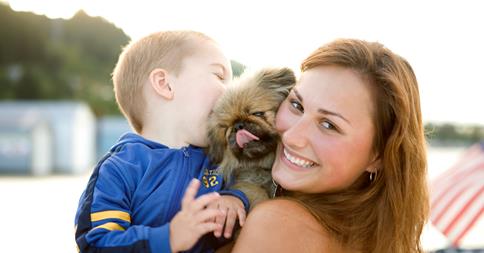Five Petiquette Guidelines For You And Your Dog Or Cat

Petiquette? Have you heard about it before?
Although Statistics Canada does not collect data on your dog, your cat and the number of pets in our country, it is safe to say that we co-exist with more pets than we ever have.
The results? We have more “pet” peeves and sticky pet situations in our daily lives.
***
As a pet owner, displaying modern manners now includes “petiquette” knowledge.
Here are five guidelines to contribute to a pet friendly neighbourhood and life.
1. Mind your dog’s manners.
Recognize, like with your children, that you are fully, 100 per cent, accountable for your pet’s behaviour, at all times. At home, while visiting or on a walk about, no matter what the others, human or animal, do, your pet is your responsibility.
It is your responsibility to find out about your municipality’s animal by-laws and to educate your pet on the dos and don’ts of society.
Foremost. make sure that you dispose of your animal’s feces in the proper public places, in the toilet or in the trash.
Make sure that your four-legged companion is up to date on vaccinations and flea-free.
Before leaving your home and interacting with others, outside of your family, your dog should obey the basic commands: “Stop”, “Down”, “Come here”, “Stay” and “Let it go.”
Depending on your destination, never leave home without your doggy’s bag: leash, poop bags, cleaning wipes, toy and/or treats.
Sticky Situation: Your neighbour’s dog barks all day long, late at night or early in the morning, pees on your lawn and flowerbeds or destroys your property.
Solution: Use a gradual process.
• Approach your neighbour, ideally face-to-face, in a friendly, non-threatening conversation of concern.
“Hi. I don’t know if you are aware of this, but Fido seems to be quite distraught when you are at work. He barks for most of the day. I would appreciate it if you could look into it.”
If you are not on chatting terms, place a note in their mailbox with your contact information.
• If the situation does not get resolved, involve the other neighbours, to document days and times for the disturbances. In writing, present your next-door dweller with the facts.
• As a last resort, seek the support of city officials to enforce the by-laws.
2. Inform your guests of your pet’s presence.
When hosting, let your guests know, prior to their arrival, that you share your home with a cat or dog.
Your guests are coming to visit you and may not be comfortable around dogs or cats. They may have suffered a trauma in childhood, may be allergic, or simply not as fond as you are of animals.
Don’t let your dog beg for food from the table.
Sticky situation: Your puppy likes to lick, nip or jump on guests to welcome them.
Solution: Enroll your playful pup in an obedience class. Until then, occupy him outside or in another room, with a treat or toy.
3. When participating in a business call at home, colleagues and clients should not be aware of your pet’s presence, unless it is “Bring your pet to work day”.
Sticky situation: Your dog, who is already in a separate room, barks while you are on a conference call.
Solution: Excuse yourself. Place your phone or video on mute. Send an Instant Message to the call’s host. Appease your pet. Return to the call while informing the meeting host.
4. Don’t assume your pet is welcome.
When invited to someone’s home for an event or a weekend, even if your host has an animal, don’t just bring him along.
Always ask if you can come plus pooch.
Before taking your four-legged friend, make sure that your pet passes the polite test. He:
• is clean and groomed.
• is comfortable in new surroundings.
• enjoys meeting new people and other pets.
• most definitely house trained.
And you, arrive with have your emergency kit; his leash, cleaning wipes, your “wet paws” towel, a bowl for water, a toy, a treat and your poop scooping equipment.
Sticky situation: Your pet has an accident.
Solution: Apologize. Clean up his mess. Dispose in the appropriate places. Make arrangements to pay for professional cleaning. Reassure your pet. Consider leaving.
Cats are generally better left behind. They get nervous in new environments. But, if you decide to bring him along and your host agrees, place kitty in a travel kennel. He will appreciate the security. Otherwise he may get nervous and urinate in your friend’s home.
5. When going out and about, be a caring canine contributor (CCC).
As a CCC, take your walking kit with you: leash, bag and gloves. A good leash length is your height. The leash will also ensure that your dog is safe from cars or dangerous items like broken glass.
If nature calls, do due diligence and abide by all bylaws. He poops, you scoop, bag, knot and dump in the appropriate receptacle. Don’t let your dog urinate on private property or even on public lawns. Solid non-living structures, like lampposts or the traditional fire hydrant are better than bushes and trees.
Even if you are a confident CCC, and know that your dog won’t hurt another, always ask permission when your dog wants to have a dog-to-dog meet-and-greet. Also ask a parent when he wants to meet a child.
“Hi! Can they exchange greetings?” Respect even a subtle no. Don’t insist.
Never give another dog a treat without first asking his owner.
Don’t discipline other pets. Speak to the owner; you are not the pet police.
Sticky situation: Another dog keeps on smelling your dog’s butt.
Solution: Although It can make you and the other dog walker blush, let it go. It is complicated canine communication. Really? Watch and learn. And if the roles are reversed, don’t discipline your dog or yank his leash. This technique could antagonize the other, from furry friend to foul foe.
No matter if you are a dog lover, a cat cuddler or prefer people, keep calm and “paw”ty on with respect for all living creatures.
Published October 3rd, 2014 Huffington Post (c) Julie Blais Comeau




